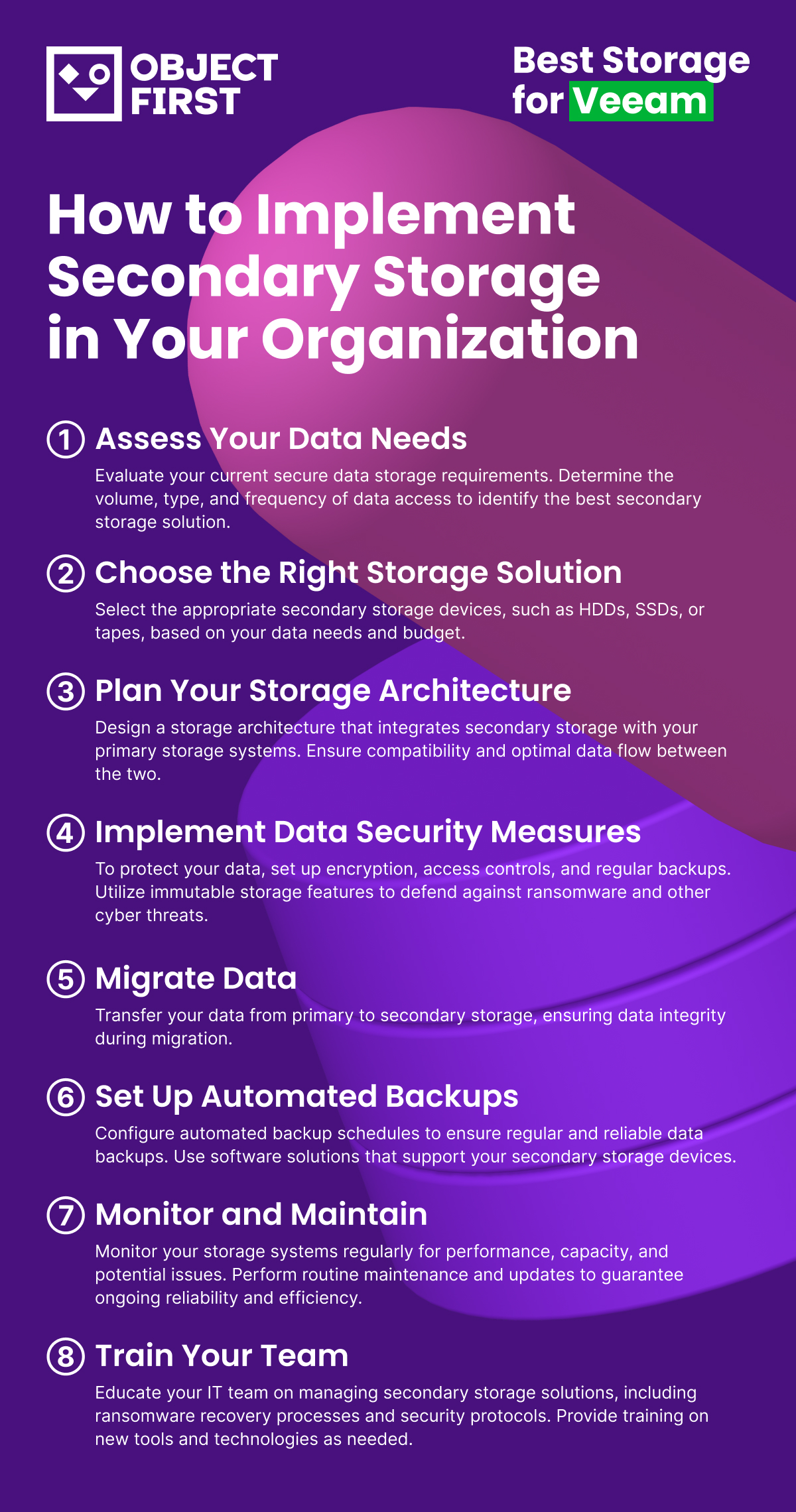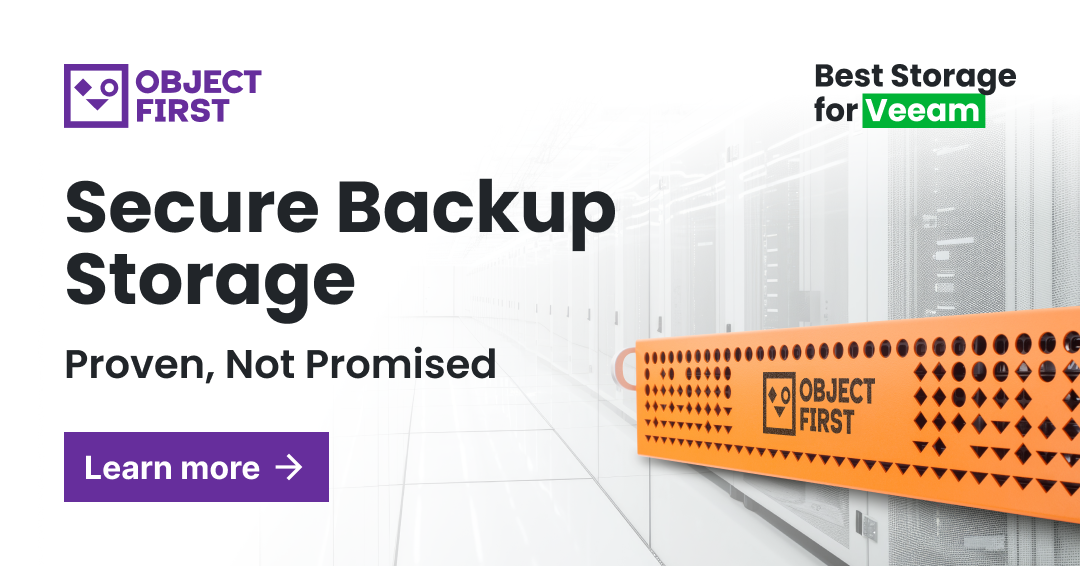Secondary Storage: Strategies for Enhanced Data Backup
With 96% of global IT decision-makers having experienced at least one outage in the past three years, this scenario is more common than you might think. Fortunately, there's a way to safeguard your data and maintain smooth operations.
Discover how secondary storage can be the key to your data backup strategy, ensuring seamless recovery and minimizing downtime.
Key Takeaways
- Understand the importance of secondary storage in protecting data, minimizing downtime, and ensuring seamless recovery from IT outages.
- Learn about the different types of secondary storage devices and how each can benefit your organization's data management approach.
- Discover how Ootbi's features can enhance your secondary storage strategy by providing robust disaster recovery capabilities, secure backups, and compliance with regulatory standards.
What Is Secondary Storage?
Secondary storage is a type of data storage that holds information not currently in use by the computer's primary storage, such as RAM[1] . This long-term, non-volatile, external storage is essential for preserving data even when the computer is turned off.
Auxiliary storage devices include hard drives, solid-state drives, USB drives, CDs, and cloud storage.
Unlike primary storage, which is fast and used for immediate access, secondary storage offers a larger capacity at a lower cost, making it ideal for backups, archives, and storing infrequently accessed data.
7 Reasons to Use Secondary Storage Devices
With global data volume expected to reach 175 zettabytes by 2025, secondary storage devices are critical for modern businesses to manage and protect large amounts of data.
Here are critical reasons to incorporate it into your data management strategy:
- Data Backup and Recovery: Secondary storage provides a safe place to store backups of your critical data, ensuring you can recover it in case of a system failure or data loss.
- Cost-Effectiveness: Compared to primary storage, secondary storage devices offer larger capacities at a lower cost, making storing vast amounts of data affordable.
- Long-Term Data Retention: Secondary storage is ideal for archiving data that you don't need to access frequently but must keep for long periods, such as compliance records and historical data.
- Free Up Primary Storage: By offloading infrequently accessed data to secondary storage, you can free up space on your primary storage devices, improving their performance and efficiency.
- Enhanced Data Security: Storing data on secondary storage devices, primarily offline or remote locations, adds extra protection against ransomware and data breaches.
- Scalability: Secondary storage solutions can quickly scale to accommodate growing data volumes, providing a flexible and adaptable storage option as your needs evolve.
- Disaster Recovery: Data stored in multiple locations ensures you can quickly recover and resume operations after a disaster or unexpected event.
Three Main Types of Secondary Storage
Since the global data storage market is expected to grow annually by 8.4%, selecting the most suitable storage solutions is crucial to keep up with increasing data demands.
Learn about the three main types of secondary storage to make an informed choice.
Magnetic Storage Devices
Magnetic storage devices use magnetic fields to store data on rotating disks or tapes. These are traditional forms of storage known for their large capacities and cost-effectiveness.
HDDs, used in desktops and servers, have spinning disks with magnetic coatings for high-capacity storage. Tape drives, which use magnetic tape, are perfect for durable backups and archival storage.
Optical Storage Devices
Optical storage devices use lasers to write and read data on discs. These are portable and durable, making them suitable for media distribution and archival purposes.
Think of CDs, DVDs, and Blu-ray discs. These optical discs offer storage capacities ranging from 700 MB to 25 GB or more and are used for storing music, movies, software, and large multimedia files.
Solid-State Storage Devices
Solid-state storage devices use flash memory to store data. These devices have no moving parts, resulting in faster access speeds and better durability.
Examples include USB flash drives, which allow quick, portable file transfers, and memory cards, like SD and microSD, which store photos and videos in cameras, smartphones, and tablets.
Primary vs. Secondary Storage: What to Consider When Choosing
Both primary and secondary storage solutions serve distinct purposes and offer unique benefits. Learn all about their aspects below.
|
Aspect |
Primary Storage |
Secondary Storage |
|---|---|---|
| Speed | Rapid access for active tasks and frequently accessed data. | Slower, suitable for long-term storage and backups. |
| Data Availability | Instantly available, essential for critical operations. | Used for data that doesn’t need immediate access, ideal for backups and archives. |
| Data Durability | More durable and reliable due to higher quality and maintenance. | Designed for longevity and stability, though less resilient to frequent access. |
| Cost | More expensive due to high-speed performance. | Cost-effective, offering large capacities at lower prices. |
| Use Cases | For active, mission-critical data and quick-access applications. | Perfect for backup, disaster recovery, and long-term archiving. |
| First Access Time | Milliseconds for rapid data retrieval. | Subsecond or longer for accessing stored data. |
| Common Storage Type | Flash/SSD for high performance. | HDD, tape, or spinning disk for cost-effective and long-term use. |
Ootbi provided the confidence that the appliance and backup files stored on it are secured. Read the Case Study

Best Practices for Managing Secondary Storage
Now that you've integrated secondary storage into your IT infrastructure, it's time to ensure it runs smoothly and securely by utilizing these six tips.
1. Organize data efficiently by categorizing and labeling it clearly for easy retrieval. Use a hierarchical structure to keep files systematically organized.
2. Implement strong security measures, such as encrypting sensitive data to protect against unauthorized access. Set up access controls to limit data access to authorized personnel only.
3. Conduct regular audits to assess the integrity and security of your stored data. Review and update data backup strategy and security protocols to ensure they remain effective.
4. Maintain data hygiene by regularly deleting outdated or unnecessary files to free up storage space. This practice also improves retrieval times and reduces storage costs.
5. Use automated tools to manage backups and data transfers. Automation reduces human error and ensures that backups run consistently and reliably.
6. Monitor storage performance to identify potential issues before they become critical. Routine monitoring maintains optimal storage efficiency and prevents unexpected failures.
Ootbi: A Prime Example of a Secondary Storage
Ransomware-proof and immutable out-of-the-box, Ootbi by Object First delivers secure, simple, and powerful on-premises backup storage for Veeam customers.
Ootbi is a prime example of a secondary storage, enhancing your backup strategies by:
- Providing robust disaster recovery capabilities for quick data restoration.
- Balancing high-performance storage with cost-effective secondary storage solutions.
- Protecting from ransomware and other cyber threats with its out-of-the-box immutability.
- Maintaining secure, tamper-proof data copies for long-term data retention and regulatory compliance.
Request a demo to learn why Ootbi by Object First is the best storage for Veeam.
FAQ
Is Secondary Storage Really Important?
Yes, secondary storage is essential for data protection and disaster recovery. It ensures that critical data is securely backed up and can be restored quickly during data loss.
How Do You Choose the Right Secondary Storage?
When choosing secondary storage, consider factors such as cost, capacity, data retrieval speed, and durability. It's important to select storage that meets your organization's specific backup and archiving requirements.
What Are the Benefits of Secondary Storage?
Secondary storage helps free up space on primary storage, reduces overall storage costs, and provides an additional layer of data security. It is essential for long-term data retention, backup, and disaster recovery.



